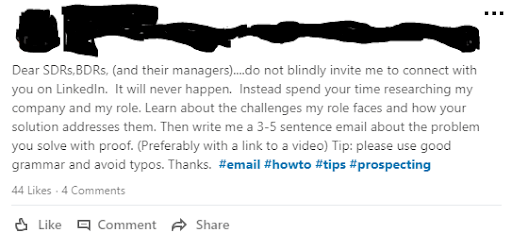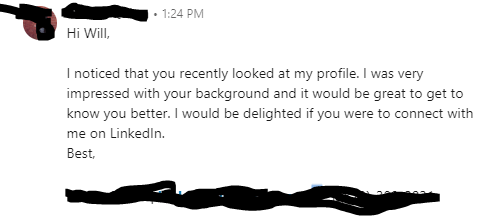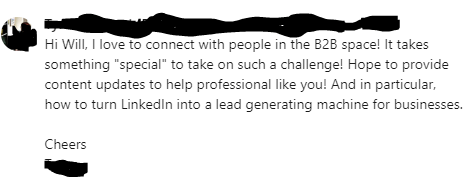Let’s get something straight: Being a Sales Development Rep (SDR) or a Business Development Representative (BDR) is one of the hardest sales functions out there. Being an SDR is literally handling rejections and objections with a constant and maniacal sense of optimism. It can be a drag.
But you should never, and I mean never, randomly request to connect with a prospect on LinkedIn.
Here’s a note from a frustrated prospect who can purchase from you, but won’t because you aren’t providing value.

Every day, well-meaning SDRs send thousands of connection invites and then immediately try to pitch their widgets (software) and doodads (services). This is especially annoying because it violates unwritten rules around people’s personal social media spaces.
“Ok, Will, but why is it happening?”
Well, there are a couple factors at play here:
- Little to no training for SDRs
- Unrealistic goals for SDRs
- Half-ass use of LinkedIn’s functionality by SDRs
Let’s break these down.
Little-to-No Training
According to Topo Inc., 72.5% of high growth companies hire SDRs with 0-1 years of experience. That is a ton of highly inexperienced people acting as the first human contact your brand has with potential customers.
To be clear, a lack of experience doesn’t mean that someone can’t complete this function. However, it does mean they need active coaching.
Sales skills, contrary to popular belief, are trainable and coachable. Often, SDRs are given a wonderful little playbook on handling objections, have a couple of their calls listened to, and then told, “Ok, get out there, hit quota, we have officially trained you.”
This is not a recipe for success. Your least experienced employee was given minimal homework then told to go out and hit some number of qualified meetings. This is nearly impossible to achieve without cutting some corners.
These expectations might be unrealistic if they are generated without factoring demand into your program. If you build your sales process strictly around revenue and your BDRs consistently fail to hit these goals, it’s time to reevaluate.
Setting unrealistic standards will contribute to the terrible outreach your SDRs are spitting into the world.
Unrealistic Goals
Your greenhorn SDR has been told they have 4 months to hit their meeting quota or get fired. According to Medium, “The average quota of an SDR is 21 meetings set or 13 qualified opportunities per month“.
It may not sound like a lot, but you need to understand how many attempted connections are needed to hit that mark. The people who invented the SDR function Salesforce claim it takes approximately 6-8 touches to generate a viable sales lead.
Your SDRs are reasonable people who want to keep their job, but also know that they need to generate potentially thousands of activities or touches per month to hit their seemingly low goal. It is no wonder they find ways to optimize their time!
Sending a seemingly innocuous LinkedIn connection request appears to be a quick way to generate a ton of “touches” in a small amount of time. Because of their minimal training, they don’t understand that a LinkedIn request isn’t a high quality or high value touchpoint for them. It especially lacks value for their potential prospects.
Half-Assed Use of LinkedIn’s Functionality
Social media is the largest conduit for human communication. Every day, millions of people converse, educate, and learn from sites like LinkedIn, Facebook, and Twitter. Untold amounts of personal information right at our fingertips!
Then out of nowhere, someone has the audacity to send this half-ass message that doesn’t utilize any information at all:

“I’d like to become a LinkedIn influencer,” is a more honest message.
This person saw my title and thought I was a great prospect, but they don’t know anything about me! I have a feeling that any relationship we had would be fairly one-sided. Even worse, they used LinkedIn’s lifeless, automated prompted message. Cringe!
Let’s look at another example:

Mmm, getting there. At least they implied they learned about me.
Here is a message that does an even better job of illustrating my point:

Winner! Ding, ding, ding!
They know who I am and their connection request is about the value they are hoping to provide in the future. Nothing in this message is an immediate ask, except for the connection. They effectively articulated why we may have a mutually beneficial relationship. Well done!
As an SDR, utilizing LinkedIn to generate leads really resonates with me. This approach is great, and I almost guarantee you it is a templated message. It likely took very little time for this person to send multiple messages and generate a large number of first touches and connections.
In other words, they did just a little bit more research using the tools available beyond simply seeing my title and deciding I could be a customer.
Stay tuned for Part Two, where I’ll show in-depth how to truly make a meaningful connection on LinkedIn with a potential prospect.
